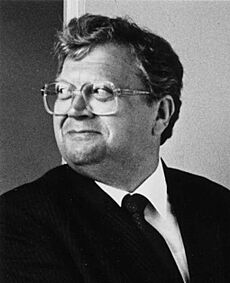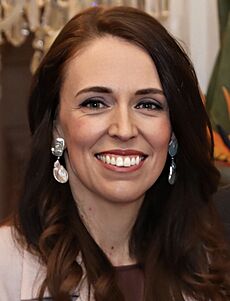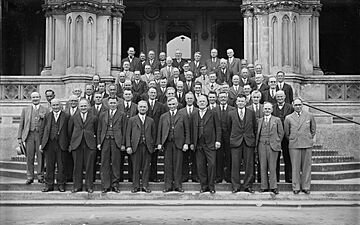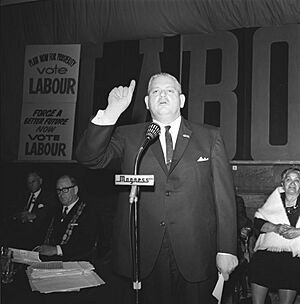New Zealand Labour Party facts for kids
Quick facts for kids
New Zealand Labour Party
Rōpū Reipa o Aotearoa
|
|
|---|---|
 |
|
| Leader | Chris Hipkins |
| Deputy Leader | Carmel Sepuloni |
| President | Jill Day |
| General Secretary | Rob Salmond |
| Founded | 7 July 1916 |
| Merger of | Social Democratic Party United Labour Party |
| Headquarters | Fraser House, 160–162 Willis St, Wellington 6011 |
| Youth wing | Young Labour |
| LGBT+ wing | Rainbow Labour |
| Ideology | Social democracy |
| Political position | Centre-left |
| International affiliation | Progressive Alliance Socialist International (1952–2014) |
| Colours | Red |
| Slogan | In It For You |
| House of Representatives |
34 / 123
|
| Regional councillors |
2 / 131
|
| Local councillors |
17 / 714
|
| Mayors |
1 / 67
|
The New Zealand Labour Party, often just called Labour (Māori: Reipa), is one of the two main political parties in New Zealand. It is a centre-left party, which means it generally supports social equality and government help for people in need. Its main rival is the National Party.
The Labour Party was formed in 1916 by various socialist groups and trade unions (groups that represent workers). It is the oldest political party in New Zealand that still exists today. Since the 1930s, Labour and National have taken turns leading the government.
Labour has had six periods in government, led by 11 different prime ministers. The party has often been supported by working-class people, Māori, and Pasifika.
The first Labour government, from 1935 to 1949, created New Zealand's social welfare system, which provides support for citizens. More recently, the party was in government from 2017 to 2023, first under Jacinda Ardern and then Chris Hipkins. After the 2023 election, Labour became the main Opposition party. As of 2025, Chris Hipkins is the party's leader.
Contents
History of the Labour Party
How the Party Was Formed (1901–1916)
At the start of the 20th century, New Zealand's left-wing politics was divided. Some groups wanted radical changes, while others preferred slower, more moderate reforms. After a major miners' strike in 1912, many felt that the different labour groups needed to unite to be stronger.
In 1916, these groups finally came together in Wellington and formed the New Zealand Labour Party. They wanted things like better representation in government and for the state to have more control over important industries.
Early Years and First Government (1916–1949)
The new party quickly faced challenges. During World War I, it opposed conscription (forcing people to join the army), and some of its leaders were jailed. Despite this, the party grew. By 1925, it had become the second-largest party in Parliament.
During the Great Depression of the 1930s, many people were struggling, and Labour's ideas became very popular. In the 1935 election, Labour won a huge victory.
Under Prime Minister Michael Joseph Savage, the first Labour government made major changes. It created a social welfare system to help the sick, unemployed, and elderly. It also started a program to build state houses, providing affordable homes for families. Savage was very popular, and many people hung his picture in their homes.
After Savage's death in 1940, Peter Fraser became prime minister and led the country through World War II. Labour remained in power until 1949, when it lost the election to the National Party.
Alternating Power (1950s–1970s)
Labour returned to power for a short time from 1957 to 1960. However, their 1958 budget, known as the "Black Budget," raised taxes on things like alcohol and cigarettes. This was very unpopular and led to their defeat in the 1960 election.
In 1972, under the energetic leader Norman Kirk, Labour won a big victory. Kirk's government was known for its strong stance against nuclear weapons testing. Sadly, Kirk died in office in 1974, and Labour lost the next election in 1975.
A Time of Big Changes (1984–1990)

The fourth Labour government, led by David Lange, came to power in 1984. This government was very different from previous Labour governments. The Minister of Finance, Roger Douglas, introduced major free-market reforms known as "Rogernomics".
These reforms involved selling state-owned companies, cutting government spending, and removing many regulations. While some believed these changes were needed for the economy, they were controversial and caused a split within the party.
This government also made New Zealand a nuclear-free zone, a policy that remains very popular today. Despite these changes, internal disagreements led to Labour's defeat in the 1990 election.
The Clark Years (1999–2008)

After nine years in opposition, Labour returned to power in 1999 under Helen Clark, New Zealand's second female prime minister. Her government governed for three terms.
Key policies during this time included creating KiwiSaver, a retirement savings scheme, and the Working for Families package to help low and middle-income families. Her government also opposed the Iraq War in 2003. Labour lost the 2008 election and went back into opposition.
Return to Government (2017–2023)

After several years and a few leadership changes, Jacinda Ardern became leader just before the 2017 election. Her popularity soared, and Labour formed a coalition government with the New Zealand First party, supported by the Green Party.
Ardern's government focused on issues like child poverty and housing. It also faced major challenges, including the COVID-19 pandemic. The government's response to the pandemic was widely supported, and in the 2020 election, Labour won a landslide victory, gaining enough seats to govern alone. This was the first time any party had won an outright majority since the MMP voting system was introduced in 1996.
In January 2023, Ardern resigned as prime minister and was replaced by Chris Hipkins. The Labour government lost the 2023 election to the National Party and is now the main opposition party.
What Labour Believes In
The Labour Party was founded on democratic socialism principles. This means it believes in state ownership of key industries and more rights for workers. Over time, the party has become more moderate and is now generally described as social-democratic.
Today, Labour aims to create a "fairer and more equal society" through a mixed economy, where both the government and private businesses play a role.
Key Principles
According to its constitution, the Labour Party believes in:
- Managing New Zealand's natural resources for everyone's benefit.
- Equal opportunities for all people, no matter their wealth.
- A fair sharing of wealth.
- Honouring the Treaty of Waitangi as New Zealand's founding document.
- Promoting peace and social justice around the world.
- Equal human rights for everyone.
Who Votes for Labour?
Historically, Labour's main supporters were urban working-class people and trade union members. Today, the party's support is broader. It is popular among young people, city dwellers, public servants, and minority communities, especially Māori and Pasifika.
Party Organisation
The Labour Party is made up of local branches in each electorate across the country. It also has special interest groups, such as Rainbow Labour for the LGBT+ community and Young Labour for members under 30.
The party's main governing body is the New Zealand Council. Policy is developed by the Policy Council and voted on at the Annual Conference.
The elected Members of Parliament (MPs) for Labour form the Parliamentary Labour Party, also known as the Caucus. The Caucus, along with party members and affiliated unions, elects the party's leader.
Images for kids
-
Members of the Labour parliamentary caucus, 1922. Prominent members are Harry Holland (seated, left of centre), Peter Fraser (seated, right of centre) and Michael Joseph Savage (back row, rightmost).
-
Then-leader Phil Goff with future leader Jacinda Ardern and Carol Beaumont at a 2010 anti-mining march in Auckland
-
Chris Hipkins, Labour Prime Minister in 2023
-
Leader Chris Hipkins (in 2022)
See also
 In Spanish: Partido Laborista de Nueva Zelanda para niños
In Spanish: Partido Laborista de Nueva Zelanda para niños










